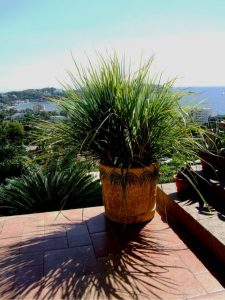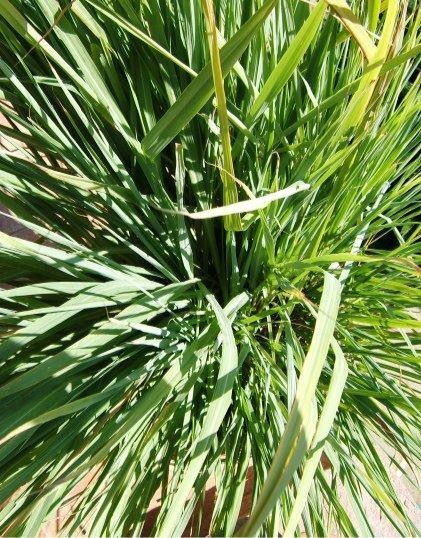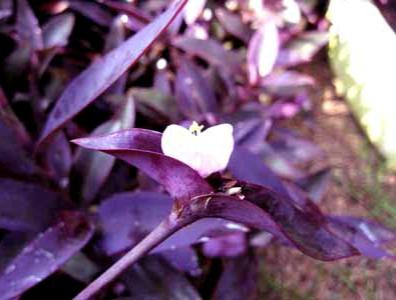By Tommy Clarkson from the September 2013 Edition

Family: Cymbopogon citratus
(Also known as: Barbed wire grass, silky heads, citronella grass, or fever grass
Perhaps not often thought of for inclusion in a tropical garden, this is – nonetheless – an interesting and, great culinary addition as Lemon Grass is effectively incorporated in a delightful array of Asian, Mexican, African and Caribbean food!
While requiring full sun and frequent watering it’s not really much of a “looker’. In fact, seldom producing flowers, this nondescript plant looks basically like a tall bunch of thick grass. Situated at the base of each group of leaves is a fat stalk that looks rather similar to a spring onion bulb. The plant whole is but a big cluster of these individual stalks.
If grown outside they may achieve heights up to 6 feet (182cm). Mine, growing in a large pot, is around 3 ½ feet (107cm).
Want to grow some? It is extremely easy to start by simply transplanting rooted stalks.
When planting, enrich the soil with some compost or well-aged manure. And those who know me will anticipate this next instruction ensure the soil is well draining! Lemongrass appreciates extra nitrogen, so fertilize twice a month during the growing season. Perhaps most importantly, water regularly, not allowing the plant to dry out particularly when the weather is very hot.
Once your Lemongrass attains a height of three feet, you may want to trim the tops and as Lemongrass doesn’t grow branches so no other pruning is necessary.
Found in temperate and tropical regions, there are approximately fifty-five species of this tall perennial grass. Native to India, the citrus flavor of Lemon Grass is widely used as a dried, powdered or fresh herb in Asian cuisine. Many westerners first encountered it through Thai or Vietnamese dishes. (Having lived a couple of years in “The Land of Smiles” Thailand my personal favorite incorporating this plant is Tom Yum Goon . . . Hot Shrimp Soup.)
When cooking with it, keep in mind that it is somewhat pungent, so use in small amounts. If one wishes, the entire stalk of the grass can be used or the grass blade can be sliced very fine often added to soups. Some prefer to use the stalk – the white part near the root is where there is more concentration of the citrusy smell.
However, most generally, the bulb is the preferred part for use in cooking. It can be bruised and then minced or grated. In fact, this aromatic grass is commonly used in a variety of culinary presentations: teas, soup, stews, curries and stir fry. It is also suitable for poultry, fish, and seafood. Its light lemon flavor of this grass blends well with garlic, chilies, and cilantro.

(A test: Does anyone remember what kind of palm that is above it and from where it originally comes?)”
It is often used as a beverage in African and Latin American countries. For a wonderful hot Lemon Grass tea, take ten or so green leaves, wash them, tie them in a knot and place in the bottom of a French Press to which boiling water is added. After about five minutes, press and enjoy!
In Thailand, the lightly sweetened, Nahm Takra, is good for cooling some of those great but spicy Thai dishes. It can be made by steeping approximately twelve lemon grass stalks in eight cups of water to which one half cup sugar (or sweetener) has been added.
Lemon Grass is also used commercially as the recognizable scent in products such as soaps, perfumes and candles.
This grass is rich in a substance called citral which is the active ingredient in lemon peel. Commonly it is used to aid in digestion as well as relieve spasms, muscle cramps, rheumatism and headaches.
Used for yet more comprehensive medicinal purposes, a research team from the Ben Gurion University in Israel found that lemon grass (cymbopogon citratus) caused apoptosis (programmed cell death) in cancer cells. Using concentrations of citral – equivalent to the quantity in a cup of tea (one gram of lemon grass in hot water) – the researchers observed that citral induces programmed cell death in the cancerous cells, while the normal cells were left unharmed.
But, back to your garden, leaf blight can hit lemongrass. If so, the leaves can start to wilt developing brown or rust colored spots on their ends. Pick away the infected leaves, and spray the whole plant with a natural fungicide that can be used on edible plants.
Lastly, cats, too, like it and may chew on your plants if given the chance.
Pretty interesting stuff for a simple clump of grass, huh?

Download the full edition or view it online
—
Tommy Clarkson is a bit of a renaissance man. He’s lived and worked in locales as disparate as the 1.2 square mile island of Kwajalein to war-torn Iraq, from aboard he and Patty’s boat berthed out of Sea Bright, NJ to Thailand, Germany, Hawaii and Viet Nam; He’s taught classes and courses on creative writing and mass communications from the elementary grades to graduate level; He’s spoken to a wide array of meetings, conferences and assemblages on topics as varied as Buddhism, strategic marketing and tropical plants; In the latter category he and Patty’s recently book, “The Civilized Jungle” – written for the lay gardener – has been heralded as “the best tropical plant book in the last ten years”; And, according to Trip Advisor, their spectacular tropical creation – Ola Brisa Gardens – is the “Number One Tour destination in Manzanillo”.




You must be logged in to post a comment.